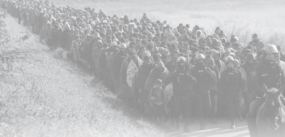Posted on 25 Oct 2019
39 found dead in truck: A tragedy, but
not an isolated incident
The tragedy of 39 people found dead in a truck in
Essex, England, on 23 October has rightly caught the attention of politicians
and the press. However, it is wrong to perceive this as an isolated incident.
The recent
incident of the bodies found in a truck in Grays is most likely an example of
human smuggling gone wrong. Similar
cases in the UK and elsewhere in Europe
clearly indicate that this is part of a far wider problem. Such incidents highlight
that approaches to tackling human smuggling that focus purely on border control
heighten the protection risks for those on the move. As discussed on Al
Jazeera’s ‘Inside Story’, calls for increasing border checks further are misguided.
Vast resources have already been poured into enhancing border control both in
the UK and the EU more broadly. The volume of freight entering the country each
day means that it is impossible for Border Force to check every single
container and truck entering the UK.
Instead, it is essential
to review state policies that close off legal and safe avenues for migration
into the UK and the EU, which force many of those wishing or needing to migrate
into irregular mobility, driving a reliance on human smugglers. In 2016, at the
height of illegal border entry detections in the EU, EUROPOL
estimated that 90 per cent of migrants and refugees moving to Europe
irregularly use the service of smugglers.
Securitizing
borders increases barriers to migration, which, in turn, stimulates demand
for the services that human-smuggling networks provide. And as those barriers
become increasingly insurmountable, the skills smugglers need to provide become
more specialized, decreasing competition, and in many cases shrinking supply.
As in all supply-and-demand markets, this drives up prices, making the human-smuggling
market more lucrative and attracting organized-crime groups. Consequently, by
investing greater resources in border control, states inflate the profits of organized-crime
groups.
As border
control increases, and safer routes are made more difficult, smuggling networks
use increasingly risky routes to move people, with devastating impacts on the
safety of those on the move. The UK
National Crime Agency’s 2019 National Strategic Assessment of Serious and
Organised Crime tracked an increase in the use of ‘containers and
refrigerated HGVs … alongside other high-risk methodologies’ (including boats),
over the last year by ‘organised immigration crime’ (the term used by the UK
Government to denote human smuggling) to move people into the UK. The report
noted that ‘this poses a significant threat to life’.
Research across a range of jurisdictions, including by the Global Initiative’s observatories on the Mediterranean and South Eastern European irregular migration routes, has repeatedly tracked how the modus operandi of human-smuggling networks shifts in response to law-enforcement efforts. In Niger, increased enforcement led drivers to take longer and riskier routes across the Sahel, often operating at night to evade detection, with a parallel increase in migrant fatalities in the desert. The increase in incidents of human smuggling and/or trafficking operations using refrigerated containers and trucks to move people into the UK could demonstrate how networks have adapted to evade heat sensors installed at certain borders.
The involvement
of the driver, or even his knowledge of the contents of the container, remains
unclear at this stage. However, even if he were aware of the people in the
container, he is most likely to be a low-level operator in the hierarchy of the
criminal network, holding limited intelligence as to the operations of the
group. Unfortunately, however, such actors form the bulk of arrests in cases of
smuggling and facilitation of irregular migration charges in the EU and elsewhere.
In its Risk Analysis for 2019, Frontex reported almost 11 000 ‘detections of facilitators’, although a far smaller number will be successfully convicted. However, it is the quality of arrests and convictions that is key, not the quantity. Law-enforcement efforts should focus on higher-level operators in smuggling networks, as drivers are easily replaceable and their arrest has negligible impacts on the group. In the EU, a number of humanitarian responders have also been charged with human-smuggling offences, in clear contravention of the intention of the Protocol against the Smuggling of Migrants by Land, Sea and Air, with its clear focus on organized crime.
At this stage,
it is not possible to conclude whether the recent tragedy was as a result of
human smuggling or human trafficking. If the latter, human-trafficking networks
between China and the UK are long-established, and ‘snake-heads’ – the term
used to denote Chinese organized crime groups – are heavily involved in money
laundering, and smuggling and trafficking of persons.
Chinese nationals were the third largest group of foreign nationals reported to the UK’s National Referral Mechanism, to which law enforcement and NGOs report victims and suspected victims of trafficking, in its most recent 2019 statistics. This has been the case since 2017, when the numbers of Chinese nationals reported overtook those from Nigeria. Albania and Vietnam have steadily remained the top two nationalities.
In combating human trafficking, the private sector is a key ally, given that a significant proportion of the over 40 million estimated to be living in conditions akin to modern slavery worldwide are believed to be in forced labour in the private sector. The UK Modern Slavery Act 2015, and more specifically the transparency in supply chains clause, constituted landmark legislation effecting this shift of responsibility onto business. However, its impact to date has been limited, as noted by a House of Lords report published in January 2019. Legislative reform is required to delineate clear enforcement action for companies breaching their legal obligations, and to make more stringent the requirements of companies’ annual human trafficking in supply chains statements.
The
investigation into the deaths of the 39 Chinese nationals is set to be a
complex and lengthy one, and the network moving these people may never be
identified. However, while state policy to counter human smuggling continues to
focus predominantly on border control, and until the private sector’s influence
is fully leveraged in monitoring human trafficking in global supply chains,
this tragedy is unlikely to be the last.
Image credits: PA WIRE/PA IMAGES



